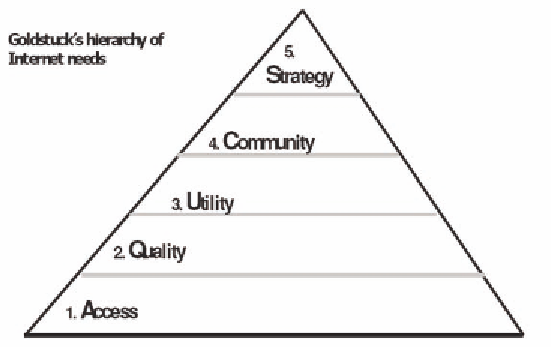Information Technology Reference
In-Depth Information
Figure 4. Goldstuck's Hierarchy of Internet Needs (Source Goldstuck (2007 82))
Table 7. Five Layers in Goldstuck's Hierarchy of Internet Needs
Access
This infrastructure level equates to connectivity and merely entails establishing a point-to-point connection into the
Internet.
Quality
This infrastructure level equates to the nature of the connection - e.g. narrowband (dial-up), broadband
(ADSL/3G/HSDPA), etc. In essence, the more mature and affordable the technology (that is, great reliability and
increased throughput rates at lower costs), the better for the user.
Utility
This value added services layer equates to the spread of applications that the consumer is able to use on the Internet.
In essence, the more online activities the user can pursue (e.g. transferring music, online banking, reading breaking
news, etc), the more favourable the experience.
Community
This value added services layer equates to a social dimension and entails the consumer reaching out and experienc-
ing the world through computer-aided human interaction. Examples include using instant messaging, joining online
discussion forums, etc.
Strategy
This value added services layer relates to the phenomenon whereby the user feels that the online world is an extension
of his/her life in the physical world. Hence, almost everything achieved offline may actually be replicated online. This
is evident in applications such as Second Life, whereby your Avatar (character) represents you in a cyber world. This
layer may also entail operating a business online, pursuing relationships on a dating portal, publishing a blog, etc.
Therefore, this layer encompasses all of the above by taking the consumer into a seamless virtual realm.
client. Much like the end user, the client pro-
gresses through the access, quality, utility, com-
munity and strategy layers as the Internet becomes
more and more fundamental to the business. The
final layers suggest that the lack of such services
would effectively cripple the business as the In-
ternet becomes an unconditional need, and is
tightly integrated into overall business processes.
The Infrastructure Focus / People Focus (y
axis) represents a similar evolution for the ISP,
which must gear up its services in accordance
with the needs of its customers (corporate users)
The ISP is challenged to provide the right mix of
technology and intellectual capital to serve the
needs of its client base in the most cost-effective
way possible.
The two axes, then, represent the respective
upgrading of requirements by the corporate user
and of the services rendered by the ISP. Inevitably,
both of these processes tend to be associated with
increasing cost.
Four quadrants in the model are identified by
considering the ISP's value proposition, whereby
the






















Search WWH ::

Custom Search